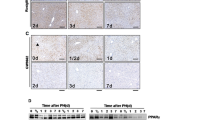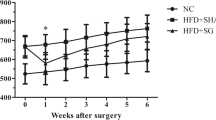Abstract
Introduction
Loss of hepatic epidermal growth factor receptor (EGFR) expression is a cause for the increased perioperative risk for complications and death in patients with obesity and fatty liver undergoing liver resection. Herein, we set out to identify agents that might increase EGFR expression and improve recovery for patients with fatty liver undergoing resection. Using the diet-induced obese (DIO) mouse model of fatty liver, we examined resveratrol as a therapy to induce EGFR expression and improve outcomes following 80% partial hepatectomy (PH) in a murine model.
Methods
DIO mice were fed resveratrol or carrier control by gavage. EGFR expression and the response to major (80%) PH were examined.
Results
Based on an Illumina analysis, resveratrol was identified as increasing EGFR gene expression in A549 cells. Resveratrol was observed to also increase EGFR protein expression in A549 cells. DIO mice fed resveratrol by gavage (75 mg/kg) demonstrated an increased EGFR expression without the identified hepatic toxicity. Resveratrol and control mice subjected to 80% PH, a model of high mortality hepatectomy in DIO mice, demonstrated macroscopically decreased fatty liver and fewer liver hemorrhagic petechiae. Resveratrol pretreatment ameliorated liver injury and accelerated regeneration of the hepatic remnant after 80% PH including decreasing serum ALT and bilirubin, while increasing hepatic PCNA expression. Resveratrol increased induction of p-STAT3 and p-AKT after 80% hepatectomy. Resveratrol pretreatment significantly improved survival rates in DIO mice undergoing extended 80% PH.
Conclusions
Oral resveratrol restores EGFR expression in fatty liver. Resveratrol may be a promising protective agent in instances where extensive hepatic resection of fatty liver is required.






Similar content being viewed by others
Abbreviations
- EGF:
-
Epidermal growth factor
- MAPK/ERK:
-
Mitogen-activated protein kinase
- min:
-
Minutes
- PCNA:
-
Proliferating cell nuclear antigen
- STAT:
-
Signal transducer and activator of transcription
- DIO:
-
Diet-induced obese
References
Behrns KE, Tsiotos GG, DeSouza NF, Krishna MK, Ludwig J, Nagorney DM. Hepatic steatosis as a potential risk factor for major hepatic resection. J Gastrointest Surg. 1998;2:292–298.
Koniaris LG, McKillop IH, Schwartz SI, Zimmers TA. Liver regeneration. J Am Coll Surg. 2003;197:634–659.
Koniaris LG, Levi DM, Pedroso FE, et al. Is surgical resection superior to transplantation in the treatment of hepatocellular carcinoma? Ann Surg. 2011;254:527–537. (discussion 537–528).
Murata H, Yagi T, Iwagaki H, et al. Mechanism of impaired regeneration of fatty liver in mouse partial hepatectomy model. J Gastroenterol Hepatol. 2007;22:2173–2180.
Torbenson M, Yang SQ, Liu HZ, Huang J, Gage W, Diehl AM. STAT-3 overexpression and p21 up-regulation accompany impaired regeneration of fatty livers. Am J Pathol. 2002;161:155–161.
Yang SQ, Lin HZ, Mandal AK, Huang J, Diehl AM. Disrupted signaling and inhibited regeneration in obese mice with fatty livers: implications for nonalcoholic fatty liver disease pathophysiology. Hepatology. 2001;34:694–706.
Gu Y, Sowa J-P, Paul A, Gerken G, Schlaak JF. Vascular endothelial growth factor improves liver regeneration and survival after 90% hepatectomy in a rat model of diet-induced steatosis. Digestion. 2013;88:235–242.
Newberry EP, Kennedy SM, Xie Y, et al. Altered hepatic triglyceride content after partial hepatectomy without impaired liver regeneration in multiple murine genetic models. Hepatology. 2008;48:1097–1105.
Au ED, Desai AP, Koniaris LG, Zimmers TA. The MEK-inhibitor selumetinib attenuates tumor growth and reduces IL-6 expression but does not protect against muscle wasting in Lewis lung cancer cachexia. Front Physiol. 2016;7:682.
Jin X, Zimmers TA, Jiang Y, Milgrom DP, Zhang Z, Koniaris LG. Meloxicam increases epidermal growth factor receptor expression improving survival after hepatic resection in diet-induced obese mice. Surgery. 2018;163:1264–1271.
Zimmers TA, Jin X, Zhang Z, Jiang Y, Koniaris LG. Epidermal growth factor receptor restoration rescues the fatty liver regeneration in mice. Am J Physiol Endocrinol Metab. 2017;313:E440–E449.
Szkudelski T, Szkudelska K. Resveratrol and diabetes: from animal to human studies. Biochim Biophys Acta. 1852;2015:1145–1154.
Kulkarni SS, Canto C. The molecular targets of resveratrol. Biochim Biophys Acta. 1852;2015:1114–1123.
Kupershmidt I, Su QJ, Grewal A, et al. Ontology-based meta-analysis of global collections of high-throughput public data. PLoS ONE. 2010;5:e13066.
Natsoulis G, Pearson CI, Gollub J, et al. The liver pharmacological and xenobiotic gene response repertoire. Mol Syst Biol. 2008;4:175.
Giebeler A, Boekschoten MV, Klein C, et al. c-Met confers protection against chronic liver tissue damage and fibrosis progression after bile duct ligation in mice. Gastroenterology. 2009;137:297–308.
Fielden MR, Brennan R, Gollub J. A gene expression biomarker provides early prediction and mechanistic assessment of hepatic tumor induction by nongenotoxic chemicals. Toxicol Sci. 2007;99:90–100.
Koniaris LG, Zimmers-Koniaris T, Hsiao EC, Chavin K, Sitzmann JV, Farber JM. Cytokine-responsive gene-2/IFN-inducible protein-10 expression in multiple models of liver and bile duct injury suggests a role in tissue regeneration. J Immunol. 2001;167:399–406.
Jin X, Zhang Z, Beer-Stolz D, Zimmers TA, Koniaris LG. Interleukin-6 inhibits oxidative injury and necrosis after extreme liver resection. Hepatology. 2007;46:802–812.
Jin X, Zimmers TA, Perez EA, Pierce RH, Zhang Z, Koniaris LG. Paradoxical effects of short- and long-term interleukin-6 exposure on liver injury and repair. Hepatology. 2006;43:474–484.
Zimmers TA, Jin X, Hsiao EC, et al. Growth differentiation factor-15: induction in liver injury through p53 and tumor necrosis factor-independent mechanisms. J Surg Res. 2006;130:45–51.
Zimmers TA, Jin X, Gutierrez JC, et al. Effect of in vivo loss of GDF-15 on hepatocellular carcinogenesis. J Cancer Res Clin Oncol. 2008;134:753–759.
Zimmers TA, Gutierrez JC, Koniaris LG. Loss of GDF-15 abolishes sulindac chemoprevention in the ApcMin/+ mouse model of intestinal cancer. J Cancer Res Clin Oncol. 2010;136:571–576.
Zimmers TA, Gutierrez JC, Koniaris LG. NAG-1/GDF-15: no evidence for an inhibitory role in colon cancer? Gastroenterology. 2007;132:1204–1205.
Jin X, Zimmers TA, Zhang Z, Pierce RH, Koniaris LG. Interleukin-6 is an important in vivo inhibitor of intestinal epithelial cell death in mice. Gut. 2010;59:186–196.
Nakajima T, Moriguchi M, Katagishi T, et al. Premature telomere shortening and impaired regenerative response in hepatocytes of individuals with NAFLD. Liver Int. 2006;26:23–31.
Strasberg SM, Howard TK, Molmenti EP, Hertl M. Selecting the donor liver: risk factors for poor function after orthotopic liver transplantation. Hepatology. 1994;20:829–838.
Zerrad-Saadi A, Lambert-Blot M, Mitchell C, et al. GH receptor plays a major role in liver regeneration through the control of EGFR and ERK1/2 activation. Endocrinology. 2011;152:2731–2741.
Seki E, Kondo Y, Iimuro Y, et al. Demonstration of cooperative contribution of MET- and EGFR-mediated STAT3 phosphorylation to liver regeneration by exogenous suppressor of cytokine signalings. J Hepatol. 2008;48:237–245.
Natarajan A, Wagner B, Sibilia M. The EGF receptor is required for efficient liver regeneration. Proc Natl Acad Sci USA. 2007;104:17081–17086.
Hajighasem A, Farzanegi P, Mazaheri Z. Effects of combined therapy with resveratrol, continuous and interval exercises on apoptosis, oxidative stress, and inflammatory biomarkers in the liver of old rats with non-alcoholic fatty liver disease. Arch Physiol Biochem. 2018:1–8. https://doi.org/10.1080/13813455.2018.144187.
Wang Y, Jiang Y, Fan X, et al. Hepato-protective effect of resveratrol against acetaminophen-induced liver injury is associated with inhibition of CYP-mediated bioactivation and regulation of SIRT1-p53 signaling pathways. Toxicol Lett. 2015;236:82–89.
Huang TH, Chen CC, Liu HM, Lee TY, Shieh SH. Resveratrol pretreatment attenuates concanavalin A-induced hepatitis through reverse of aberration in the immune response and regenerative capacity in aged mice. Sci Rep. 2017;7:2705.
Chan CC, Cheng LY, Lin CL, Huang YH, Lin HC, Lee FY. The protective role of natural phytoalexin resveratrol on inflammation, fibrosis and regeneration in cholestatic liver injury. Mol Nutr Food Res. 2011;55:1841–1849.
Kirimlioglu H, Ecevit A, Yilmaz S, Kirimlioglu V, Karabulut AB. Effect of resveratrol and melatonin on oxidative stress enzymes, regeneration, and hepatocyte ultrastructure in rats subjected to 70% partial hepatectomy. Transplant Proc. 2008;40:285–289.
Okay E, Simsek T, Subasi C, et al. Cross effects of resveratrol and mesenchymal stem cells on liver regeneration and homing in partially hepatectomized rats. Stem Cell Rev. 2015;11:322–331.
Kantartzis K, Fritsche L, Bombrich M, et al. Effects of resveratrol supplementation on liver fat content in overweight and insulin-resistant subjects: a randomized, double-blind, placebo-controlled clinical trial. Diabetes Obes Metab. 2018;20:1793–1797.
Fogacci F, Banach M, Cicero AFG. Resveratrol effect on patients with non-alcoholic fatty liver disease: a matter of dose and treatment length. Diabetes Obes Metab. 2018;20:1798–1799.
Rahman A, Assifi MM, Pedroso FE, et al. Is resection equivalent to transplantation for early cirrhotic patients with hepatocellular carcinoma? A meta-analysis. J Gastrointest Surg. 2012;16:1897–1909.
Acknowledgments
This work was supported by the Lilly Endowment, Inc. Physician Scientist Initiative and National Institutes of Health Grants GM6360301 (L.G.K.), CA122596 and GM092758 (T.A.Z.).
Author information
Authors and Affiliations
Contributions
Jin, Zimmers, and Koniaris were involved in the concept and design; Jin, Zhang, and Zimmers conducted the experiments; Jin, Zimmers, Zhang, and Koniaris interpreted the data; Jin, Koniaris, and Zimmers drafted the manuscript; Jin, Zimmers, Zhang, and Koniaris were involved in critical revisions.
Corresponding author
Ethics declarations
Conflict of interest
The authors declare that they have no conflict of interest.
Rights and permissions
About this article
Cite this article
Jin, X., Zimmers, T.A., Zhang, Z. et al. Resveratrol Improves Recovery and Survival of Diet-Induced Obese Mice Undergoing Extended Major (80%) Hepatectomy. Dig Dis Sci 64, 93–101 (2019). https://doi.org/10.1007/s10620-018-5312-0
Received:
Accepted:
Published:
Issue Date:
DOI: https://doi.org/10.1007/s10620-018-5312-0




